Melbourne is celebrating a transport landmark anniversary of 140 years since its first cable tram came into operation. The Melbourne tram milestone signified a major change in the city’s transportation across the busy streets. On 11 November 1885, the first cable tram started its route from Spencer Street to Bridge Road in Richmond.
It was a daring, up-to-date idea when horse-drawn carriages were the only transport on the roads. This innovation spread to the whole world and to other cities in Australia, and established a system that would become the city’s identity for decades.

Melbourne marks 140 years since its first historic cable tram launch.
How Did Cable Trams Transform City Travel?
The introduction of the cable tram reverberated through the young and rapidly developing urban areas of Melbourne. The system employed an underground cable for pulling the carriages, which had been powered by huge steam engines located at the depots. In the 1920s, at its height, almost 600 cable trams were running through the city.
Originally, they were able to go 13 km/h, but soon became able to reach 21 km/h because of system improvements. Public transport thus became reliable and affordable for the lower class due to its efficiency. Melbourne’s cable tram history is a clear illustration of how rapidly technology transformed the city’s mobility and planning in the late 19th century.
Why Does The Melbourne Tram Milestone Matter?
Melbourne tram milestone is important because it underscores the birth of what is now the largest tram network in the world. Transport historians point out that the long-lasting tramway culture in Melbourne was really initiated by the adoption of the very first cable systems. During the peak time, cable trams were running on more than 75 kilometres of lines all over the city.
A lot of the already existing tram lines still go on over those original tracks, making the current passengers feel like they are riding on the same lines laid down in the 1880s. The cable tram network closed down in 1940 after 55 years of operation, but its impact went on to be seen all over the city.

Melbourne tram milestone celebrates origins of world’s largest tram network.
Cable Tram Legacy Shaped Melbourne’s Character
The cable tram legacy in Melbourne goes beyond just transportation. It also affected the city’s image, its sound, and its daily life. The trams were called “magical” by the people who lived in those times because they were, in a way, silently sliding through the streets just as the electric engines were, without the smoke and the horrible odour of the steam engines.
The service was very accurate and frequent; some trams were running every 30 seconds at peak hours. This led to comfort for the citizens in commuting to their work, interactions, and education. Besides, the cable tram made it very easy to travel to town from far places, so that the suburbs started to grow as a result of people wanting to live there, thus influencing the city’s development as a vibrant metropolis.
Transformation From Cable To Electric Network
Electric trams were introduced in Melbourne due to the advancements in technology that took place around the beginning of the 1900s. However, the change from one system to the other was not a swift one, because the cable system was still in place and the existing infrastructure was being used. It would have been prohibitively expensive to get rid of the underground cables, hence many roads just converted to electric instead.
This gradual changeover let Melbourne keep its vast network intact without having to restart from zero. The choice made by the city to adapt the system rather than completely overhauling it was indeed a glimpse into the future. Present-day tram routes are still following the same paths that were once traced by the early cable trams over a century ago.

Melbourne’s shift to electric trams evolved slowly due to costly infrastructure.
Celebrating The Cable Tram Anniversary In Melbourne
The Cable tram anniversary Melbourne celebration is not solely about the past; it is about rightly recognising the three major pillars of urban heritage, that is, innovation, resilience, and the city’s past. The 140-year milestone reminds the locals that frequently the progress is built on the sturdy grounds of the previous system.
Trams in Victoria continue to be a symbol of the city’s pride as they are the most used means of transportation, with millions of passengers every year. The transition from the ringing of bells in 1885 to the muted noises of the present-day conurbation has been gradual, but it continues. The commemoration provides an opportunity for the citizens to reflect on the journey Melbourne has made and how its trams still determine the city’s pulse.
Also Read: Australia Prepares for World Tram Driver Championship 2027
FAQs
Q1: When did Melbourne’s first cable tram become operational?
The very first cable tram started to operate on November 11, 1885, and the route was from Spencer Street to Bridge Road in Richmond.
Q2: What was the peak number of cable trams in operation at the time?
During its peak in the 1920s, up to 600 cable trams were running in different parts of Melbourne.
Q3: What was the lifetime of the cable tram system in Melbourne?
The cable tram network was in operation for 55 years from 1885 to its last closure in 1940.
Q4: In what ways is the Melbourne tram system important on a global scale?
Today, Melbourne has the largest modern tram network in the world, and this is just one of the many benefits it reaps from the trams’ historical legacy, as these routes were the same as those of the cable trams in their era.












